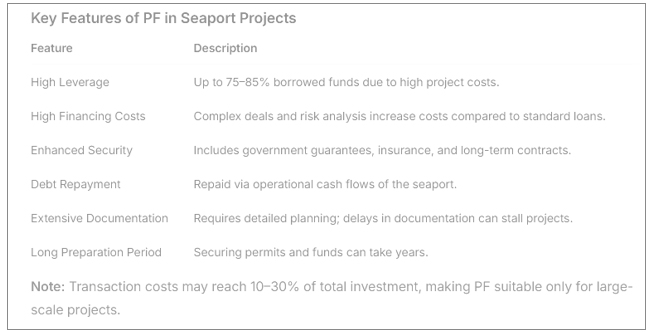Financing Seaport Projects: A Concise Guide
Global seaports are adopting innovative financing models to boost efficiency and competitiveness amid rising costs and competition. Collaboration between private firms and governments drives maritime trade in a globalized economy. This guide outlines modern financing methods like project finance (PF) and public-private partnerships (PPPs), key trends, and benefits.
Evolution of Seaport Financing
Traditional public funding for seaports has shifted due to escalating infrastructure costs. Shipping companies can no longer absorb multimillion-dollar expenses, prompting new solutions. Governments and private entities now use complex financial models, including long-term loans, bonds, grants, and PF instruments.

Benefits of PF
- High debt capacity (up to 80% of costs).
- Isolates project risks from initiators via Special Purpose Vehicles (SPVs).
- Links financing to future cash flows, not current sponsor finances.
- Enhances creditor confidence through transparent structures.
- Offers tax and investment incentives.
Structure of PF
A typical PF setup involves an SPV to isolate project assets and risks. Key participants include sponsors, lenders, and governments. SPVs, often structured as joint-stock companies, ensure transparency and limit recourse to shareholders.
Financial Dynamics
PF relies on off-balance-sheet financing, tying debt repayment to future seaport revinues. this increases lender risk but incentivizes timely project completion. Below is a simplified view of cash flow dynamics over a project lifecycle.

Current Trends in Seaport Funding
Shift to Private Capital
Western Europe increasingly transfers port infrastructure ownership to private entities, maintaining public oversight via PPPs. This trend extends to Central/Eastern Europe, Asia, Africa, and Latin America, driven by public funding deficits.
Public-Private Partnerships (PPPs)
PPPs combine state control with private initiative, offering flexibility in:
- Building new seaports and terminals.
- Expanding or modernizing existing infrastructure. Private firms often manage and co-finance projects under long-term leases (25–30+ years), covering:
- Water area setup (channels, anchorages).
- Breakwaters and berthing lines.
- Storage areas, access roads, and railways.
Revenue Models
Ports earn via tonnage fees and reduced rents, while lessees profit from transshipment and storage services. Mixed models split costs between public and private parties.
Regional Insights
Studies from the European Bank for Reconstruction and Development highlight growing private investment in developing regions. EU funds are expected to further support seaport projects, encouraging co-financing.
Services Offered by Phaeron Transformative Ventures
PNTV provides tailored financing for seaport projects globally (Europe, USA, Canada, Latin America, Asia, Middle East, Australia). Services include:
- Loans of €50M+ with up to 20-year terms.
- Combined PF instruments to protect originator assets.
- Financial modeling, SPV setup, and consulting.
For inquiries, contact PNTV representatives.
